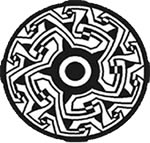- Reclamation
- Cultural and Paleontological Resources
- Hoover Dam Floor Design History
History of Hoover Dam Floor Designs
These striking, graphic, southwestern designs are incorporated in the terrazzo floors of Hoover Dam and Powerplant. The Bureau of Reclamation hired Allen T. True, a Colorado painter who specialized in depicting Western and Native American themes, to apply his artistic talent to the massive concrete structure. True believed that the use of color and decoration in industrial buildings was important to instill beauty as well as function. He wrote, "No longer can turbines, tunnels, galleries, cranes, generators, and control boards be assembled with the sole consideration of service and efficiency when, without in any way interfering with function or adding much to cost, these items can be built into a magnificent and inspiring thing of beauty - beauty in a new and modern form (The Reclamation Era, January 1936)."
True thought that Native American motifs taken from pottery, baskets, and sand paintings of the Colorado River watershed were perfect for use at Hoover Dam. Among his designs are adaptations of Pima, Acoma, and Mimbres patterns. "For character, style, and distinction there is nothing to compare with them, and their inherent boldness makes them peculiarly adaptable for use in connection with modern architecture (The Reclamation Era, January 1936)." It took almost a year to install the elaborate terrazzo floors. J.B. Martina Mosaic of Denver, Colorado, performed the work between 1936 and 1937.
 |
 |
 |

